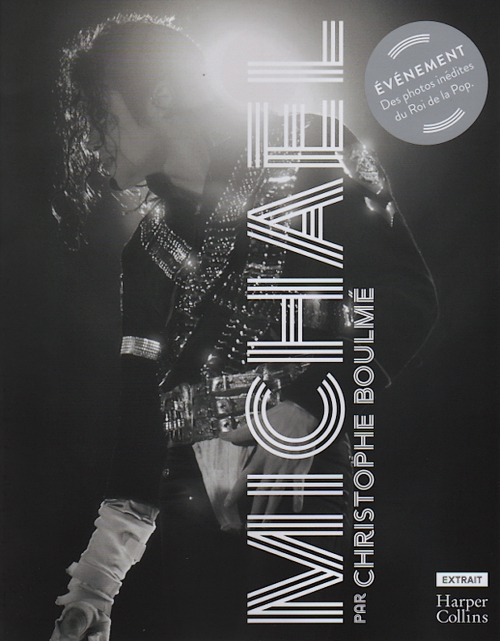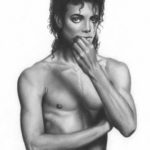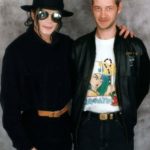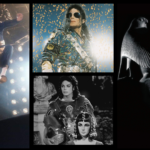(Harper Collins, 2019)
At last, I am holding the object in my hands and at this moment, I want to take my time to appreciate it, slowly turning the pages. This new book by Christophe Boulmé must be fully appreciated, as it is the result of an important part of his experience, with its text taking the readers deep into the impressions and memories of its author. As the narrator, he necessarily offers a more personal and different vision to our own memories linked to Black & White, the French magazine dedicated to the King of Pop during the 90s. A beautiful adventure in which Christophe was the artistic director, alongside editor-in-chief Laurent Hopman and publication director Julien Derain. The result for this team was a close relationship with the singer who had approved and supported their project. For the most nostalgic readers, many photos will take people of my age back into the atmosphere of the magazine, but the many unpublished pictures are there to convince us that this book highlights Christophe’s work and artistic world above all. All these images reflect the record of a collaboration that was so special in Michael Jackson’s career, and it is a pleasure to browse through this book to better decipher it.
Beyond a quality layout highlighting all the work accomplished, we learn more about the author’s personal journey. Humble and voluntarily withdrawn, he had never communicated on any intimate aspects such as his personal journey or his fan experience. This is the right moment to go through them by turning the pages, as if to relive this communion between two artists who did not need to speak the same language to understand each other. More generally, this book offers some kind of a Backstage Access Pass to dive into the archives of an artist who only wants to share them.
I remain fascinated by the small details that forge a trajectory, and Michael Jackson himself sang that every day creates our HIStory. From the very first pages, we understand that Christophe, due to his own path, could not remain insensitive to the King of Pop’s talent. He himself has this artistic flame that laid dormant in him while he remained a rather introverted and reserved boy. We discover the passion he’s had for drawing and photography since he was very young, while living in his little bubble. It is in this context, with the freedom he needed, that he would always be the most comfortable to express himself, and it is an important key to the beautiful story between both artists.
In his fan experience, far from suspecting that he could be assimilated to a pioneer, the images and illustrations of this pre-Historic period are numerous, but I choose to come back to the famous drawing that allowed him to join the Black & White team, especially since he reveals it in its entirety. Considering his approach at the time, he then wishes to show something else and evokes this drawing as a fantasy on paper, imagining the singer thin and dry but still strong, as a way of humanizing him through an image that would be less bland and without the usual numerous artifices. This sketch is in the image of Christophe’s work, a fan with total freedom, to the point of ignoring certain established Jacksonian codes that the singer then wished to control in his communication.
The story goes on and on through the pages, and a fan’s works finally appeared in an album booklet. Still, it is interesting to feel that this new closeness with his idol had not changed Christophe’s behavior in any way. He was doing things to live his passion intensely. The graphic designer had not changed, he remained the admirer who drew his inspiration from Jackson’s universe. There was no calculation in his mind, he was still the same person who drew Michael in his corner, just for his own pleasure.
However, Christophe’s skills are not limited to his illustrations, and his versatility in photography remains one of the fascinating elements of his palette. Thus, in this beautiful book, we can (re)discover many pictures of the King of Pop expressing himself on a stage. Some of the classic shots that accompanied our lives as fans had to be there, but Christophe has added many pieces from his archives to surprise us again about a figure we know so well.
During the Dangerous Tour, between elbowing your way through in the lion’s den in Rotterdam, and the quietness in the Land of the Rising Sun, only a few months had passed. From this first experience with the concert starting in broad daylight at the end of June, until December 31, 1992, one can look how far Christophe had come which would be confirmed with the World Music Awards (in Monaco), the HIStory Tour and Wetten Dass (the famous German show). All these images go by while we turn the pages and become aware that we are discovering an artist with a camera, at the service of another in movement on a stage. The author’s sensibility necessarily led him to have a different approach from his colleagues, because for them, whether the photo was beautiful or not, it would remain a big seller. Some photos that were no good could still serve the tabloids and other paparazzi, and would always find a taker. Christophe was in a different state of mind, one that would serve the image of Michael Jackson: his goal was for Michael to be sublime to the point of being at his service and totally honored by his mission that we can experience again in this book, and it is another of the keys to our pleasure in reliving the experience we had in the pit during the concerts.
In this account, we can also feel the importance of the closeness between Bob Jones (the vice-president of MJJ Productions and kind of the singer’s right-hand man) and the Black & White team. We can better perceive the importance of that figure in the King of Pop’s entourage and we feel grateful because he worked so hard for this relationship with Laurent, Julien and Christophe. I won’t go into the details related to the chapters discussing “Ghosts” and the shooting of the “Stranger In Moscow” video. In his account, Christophe opens up a lot, through the text and the images (many of which were unpublished before), and this is one of the highlights of this book. The best way to relive this shooting is to read this chapter. However, I will not forget Bob Jones’s words to Laurent, Julien and Christophe: “If you are there, it’s because you are doing a good job.” This says it all…
Let us not forget that it was during this period of time that Christophe’s works were selected for single covers – an important turning point that the author tells us with a lot of details so that we can feel his emotion at that moment.
More generally, the author expresses himself with real honesty to the point of sharing his feelings about the 2000s with a little less enthusiasm. This cry from the heart is all the more touching in that we feel an unabashed sadness, as if the “Dangerous” and “HIStory” eras were those when he felt that Michael Jackson was at his peak. It is however interesting to decipher the photographer’s analysis of that complicated time for the King of Pop – as if the Michael Jackson and Friends concert on June 27, 1999 at the Olympic Stadium in Munich marked the end of an era and the golden times. On this subject, I greatly appreciated the previously unpublished photos of this concert in the book. The photographer seemed to be with the audience in the pit and offers an immersion into the magic of seeing the artist on stage. Maybe I also like these pictures because it was on that day that I first saw Christophe. I had noticed his beautiful HIStory Tour jacket but I hadn’t dared to talk to him: I didn’t think I would ever do it and I’m glad I have since, but I’ll come back to it later.
In this year 2019, a very sensitive one for Michael Jackson’s fans, it is therefore important to welcome this release. This is a tribute to the singer’s artistic world, and we can only rejoice to finally feel positive waves throughout the pages.
On a more personal note, I am proud to have contributed to the preview of this book at the MJ MusicDay in Lyon with Association On the Line. The purpose of our events is to host collaborators and it would have been an unforgivable mistake not to invite Christophe Boulmé for the occasion of the publication of his book. I was proud to share the stage with him about this project, and I will be eternally grateful for his trust. Seeing him discover his work and feeling his emotion on that day was something very poignant, and the people who were there know what I am talking about.
In this review, I do not intend to put myself in the spotlight but I have a certain affection for this book project because Christophe has sometimes consulted me in its elaboration, and I am very touched to be thanked alongside Laurent Hopman, Julien Derain and especially Michael Jackson. I would never have imagined such a thing and I still can’t imagine it…
Thank you so much, Christophe. I remember the personal memory you told me a few months ago, especially since it is related to an imagery that is in the book, a little bit like each photo or illustration had its own story in your journey that is so rich and deserving our interest and time. Not without recognizing your beautiful tribute to Michael, I would like to finish this review with your own words because they touched me, if you allow it. They express your benevolence, your hypersensitive style and your sensitivity as an artist so well. I will never forget them.
“My best friend, whose name was Daniel Corrodera, was a graphic designer like me, but in another field, in Le Mans. He was a streetlight dresser and an industrial designer. One day, I called him for help because I had an idea and I knew he was very good and better than me at airbrushing and painting. I told him about my choice to redo the E.T. poster but with the hand of Michael Jackson this time. That’s how it all started and he made it happen. That’s how this work was published in Black & White. Michael’s communication department wanted to use it and it became the illustration for the month of January in the official Danilo 1995 calendar. The day we learned about it, I called my buddy to tell him the information but he died the same day, after being hit by a motorcycle. Maybe he rode like crazy on his bike because he was euphoric with the news…
It is probably the most consistent collaboration of my whole career, the one that has worked best. It’s a hell of a memory, a hell of a pride… When I went to Le Mans to pick up the work, I was so proud of him because it was such a success…”








